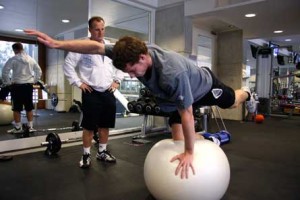 What an amazing Wimbledon we had in 2013!
What an amazing Wimbledon we had in 2013!
As a Brit, it was amazing to see Andy Murray finally win the big one.
What I found interesting was the amount of injuries suffered during the tournament. On one day alone, nine players dropped out through injury. So why would this be?
Firstly, tennis is an extremely intense, fast moving sport that requires strength, speed, power, flexibility, coordination, balance and endurance. The physical and mental demands to remain at the top of the sport are immense.
I have no doubt that it is a combination of factors as to why so many players were injured in this year’s tournament.
Firstly the ATP and WTA tennis tour schedules are brutal. As a strength coach, it is extremely challenging to condition an athlete when they have little to no rest in between tournaments and often fly hundreds or thousands of miles between events.
Also, the players have to switch between different court surfaces and the movements patterns on different surfaces can change greatly.
However, why is it that the likes of Murray and Djokovic can go through the tournament injury free and play amazing tennis whilst others fall by the wayside?
 Is it just that they have superior genetics to the others and have a greater capacity for stress and therefore able to survive their schedules and gruelling training regimes?
Is it just that they have superior genetics to the others and have a greater capacity for stress and therefore able to survive their schedules and gruelling training regimes?
Or is it down to superior conditioning programs from their teams and greater medical back up?
My hunch is that it is a combination of both.
The question then is, what can players and their back-up teams do to minimise injury and maintain ultimate performance?
Here are a few of my suggestions:
- Ensure that their training schedule follows the flexibility > stability > strength >power continuum. This continuum unfortunately is not often completed and this often ends in injury.
- Regular assessment of static and dynamic posture to identify potential injury causes before they occur. Any postural faults found can be corrected and injury can be avoided before it occurs. Also, objective measurements can be re-assessed and monitored to ensure the programme they are on is working.
 Only use resistance training modalities that allow the player to maintain their own centre of gravity over their own base of support. After all, you need to do this on-court. Using fixed resistance machines is not a good idea and will de-train the nervous system and possibly lead to a Pattern Overload injury. It will also encourage the limbs to work without prior contractions of the core’s inner unit muscles. This will decrease joint stability and increase the likelihood of injury and reduce strength, power and speed.
Only use resistance training modalities that allow the player to maintain their own centre of gravity over their own base of support. After all, you need to do this on-court. Using fixed resistance machines is not a good idea and will de-train the nervous system and possibly lead to a Pattern Overload injury. It will also encourage the limbs to work without prior contractions of the core’s inner unit muscles. This will decrease joint stability and increase the likelihood of injury and reduce strength, power and speed.- Avoid excessive cardio training. Tennis requires speed and power and too much cardio will reduce a player’s speed and power. Also, excessive cardio training reduces time available for recovery.
- Meticulous preparation of the player’s schedule and periodisation of their training plan to avoid over training.
- Include activities to aid recovery and reduction of stress such as meditation, yoga, infra red saunas etc. It is well known that Andy Murray participates in Bikram Yoga regularly.
- Techniques such as ice baths and contrast baths and showers can also be used to aid recovery.
- A sleep routine that ensures optimal sleep at optimal times to ensure the best recovery of the mind and body. In addition, a carefully adjusted sleep routine when changing time zones.
- A high quality diet consisting of organics foods that are in alignment with their metabolic type®. This can be challenging and requires planning ahead of time to establish where good food can be bought in the location of the upcoming tournament.
- Foods that cause an immune response (food sensitivities) should be avoided completely. It’s no secret that Novak Djokovic went from world number 4 to world number 1 very quickly after eliminating his sensitive foods (especially gluten) from his diet.
- One thing that all tennis players receive, but should not be over-looked is sports massage. Whilst almost all pros have daily treatments, anyone playing regular tennis in my opinion should be having a deep tissue massage at least weekly.’ Regular massage will help to relieve tension in the muscles, remove metabolic waste and help to prevent tennis specific muscle imbalances.
- Another obvious task is to ensure a complete warm-up before training and competition. Warm-ups should start at low intensity building up gradually to more tennis specific and faster movements until a light sweat is achieved.
If you are involved in conditioning tennis players or if you play tennis yourself, stayed tuned for future blogs when I will be announcing some very exciting news…
